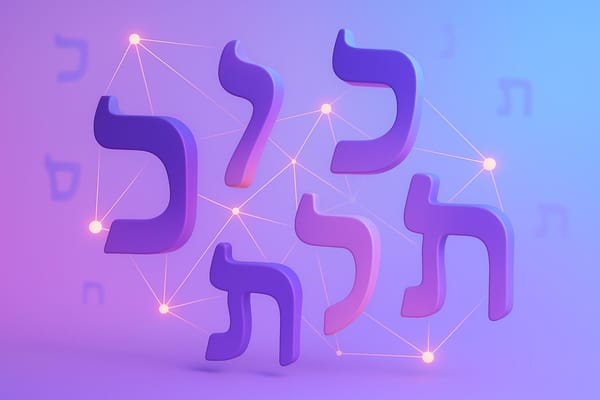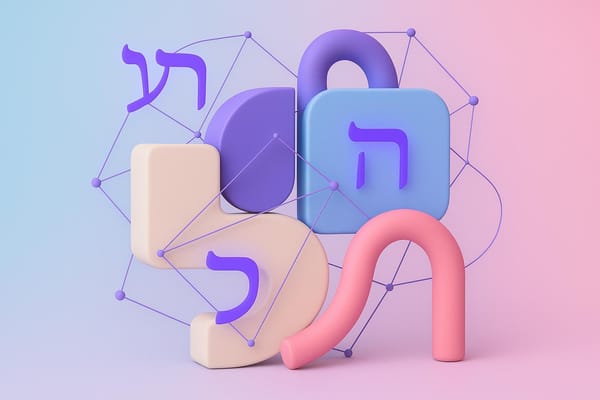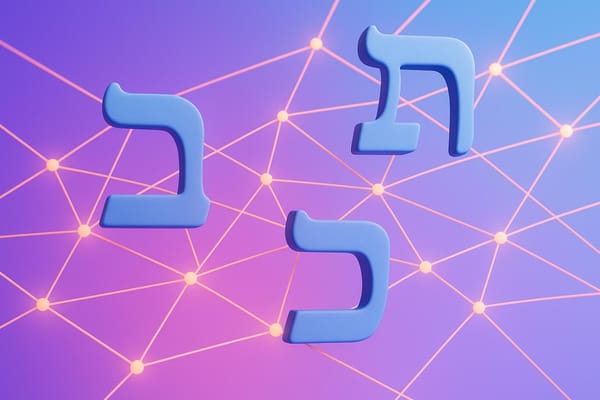10 Common Hebrew Translation Mistakes to Avoid
Learn about the 10 common mistakes in Hebrew translation, from gender confusion to cultural references, and how to avoid them for better accuracy.

Translating Hebrew can be tricky. From gendered language to idioms, vowel points, and cultural nuances, even small errors can completely change the meaning. Here’s a quick rundown of the most common mistakes and how to avoid them:
- Gender Confusion: Hebrew words, verbs, and numbers are gendered. Mismatching genders can lead to awkward translations.
- Misunderstanding Idioms: Literal translations of phrases like חבל על הזמן ("amazing") can lose their true meaning.
- Ignoring Vowel Points: Without vowel marks, words like ספר can mean "book", "barber", or "counted" depending on context.
- Mixing Up Similar Words: Words like michnasayim (pants) and mishkafayim (glasses) sound alike but mean very different things.
- Verb Conjugation Errors: Hebrew verbs change by tense, gender, and number - getting these wrong can confuse readers.
- Overlooking Context: Words like hikriv can mean "sacrifice" or "bring near" depending on usage.
- Forgetting the Dual Form: Hebrew has a special form for pairs, like yadayim ("hands") or shvu'ayim ("two weeks").
- Preposition Mistakes: Hebrew prepositions don’t always align with English, leading to errors like "spoke in the phone" instead of "on the phone."
- Misreading Acronyms: Religious and modern Hebrew acronyms like ז"ל or שב"כ carry important meanings that can’t be ignored.
- Missing Cultural References: Phrases like חג שמח ("happy holiday") require cultural awareness to use correctly.
Most Frequent Mistakes in Hebrew and How to Avoid Them
1. Confusing Gendered Words
Hebrew assigns gender to nouns, verbs, adjectives, and numbers, following specific patterns. Feminine nouns typically end with ה (hey) or ת (tav), like שִׂמְלָה (dress) and מַחְבֶּרֶת (notebook). But there are plenty of exceptions, which often trip up translators.
Common mistakes include mismatched adjectives (e.g., pairing masculine adjectives with feminine nouns like 'pizza') and using the wrong numerical forms for a noun’s gender. For example, 'three houses' (שלושה בתים) takes the masculine form, while 'three hills' (שלוש גבעות) uses the feminine form.
Here’s a quick reference table to clarify gender usage in Hebrew:
| Word | Gender | Correct Usage |
|---|---|---|
| Television (טלוויזיה) | Feminine | Must use feminine adjectives |
| Radio (רדיו) | Masculine | Must use masculine adjectives |
| Student (תלמיד/תלמידה) | Both | תלמיד (male), תלמידה (female) |
To avoid these gender-related errors, use reliable lexicons to confirm a noun’s gender, and always consider context. For instance, words like מורה (teacher) can refer to either gender, but Modern Hebrew often leans toward one form. Also, masculine forms are typically the default for mixed groups, which can lead to misunderstandings if not handled carefully - especially in professional settings where precision is key.
Gender mistakes can easily damage the quality of a translation, particularly in formal or business contexts. With gendered language covered, let’s move on to another tricky area: translating Hebrew idioms, where literal translations often miss the mark.
2. Misunderstanding Idioms
Hebrew idioms can be tricky because their literal translations often don’t match their actual meanings. Getting these right is essential for accurate translation.
For example, the idiom חבל על הזמן (literally "shame on the time") actually means "amazing", while על הפנים ("on the face") translates to "terrible." These examples highlight how relying on word-for-word translation can lead to confusion.
Here’s a look at some commonly misunderstood Hebrew idioms:
| Hebrew Idiom | Literal Translation | Actual Meaning |
|---|---|---|
| חבל על הזמן | Shame on the time | Amazing |
| על הפנים | On the face | Terrible |
| לשבור את הראש | Break the head | Think hard |
| הגיעו מים עד נפש | Water reached the soul | Overwhelmed |
| הסנדלר הולך יחף | Shoemaker walks barefoot | Not practicing what they preach |
| לשים עין | Put an eye | Keep watch |
To navigate these challenges, translators should focus on the context, consult trusted sources, and prioritize the intended meaning over the literal one. For instance, a modern phrase like תתחדש/תתחדשי (literally "be new") is commonly used to wish someone joy in using something new.
"Like their counterparts in other languages, Hebrew idioms do not derive their meaning from the normal meaning attached to the words that make up the idiom."
Now that idioms are unpacked, let’s dive into another key challenge in Hebrew translation: how vowel points help preserve meaning.
3. Ignoring Vowel Points
Modern Hebrew often leaves out vowel points (נִקּוּד/niqqud), making some words ambiguous without context. For example, the word 'ספר' can have multiple meanings depending on the vowel points, as shown below:
| Vowel Points | Word | Meaning |
|---|---|---|
| סֵפֶר | sefer | book |
| סַפָּר | sapar | barber |
| סָפַר | safar | counted |
| סִפֵּר | siper | told |
Without these marks, understanding can become tricky, especially for non-native speakers. Native speakers often rely on context to decipher the meaning, but translators need to be extra cautious. Here are a few practical tips to help:
- Use reliable tools: Digital Hebrew keyboards and specialized software that include vowel points can be invaluable.
- Pay attention to context: Modern Hebrew texts often depend on context to clarify meaning when vowel points are absent.
- Double-check religious texts: For religious or historical documents, vowel points are often crucial for accurate interpretation.
Overlooking vowel points can lead to major errors, particularly when working with texts that are ambiguous or less familiar.
"English speakers learning Hebrew often ask, 'Where are the vowels?'" - IvriTalk
The Masoretes introduced vowel points to standardize pronunciation and avoid mistakes. These marks help indicate vowel length, the absence of vowels, and differences between similar words, while also guiding proper pronunciation.
For modern texts that lack vowel points, online tools can add them automatically. However, these tools should complement - not replace - a solid understanding of Hebrew vowel points and their role in translation.
Now that we've tackled vowel points, let's dive into another common challenge: mixing up similar Hebrew words.
4. Mixing Up Similar Words
Hebrew's complexity often leads to confusion between words that sound alike but have entirely different meanings. This issue can impact everything from casual chats to high-stakes professional translations.
Take, for example, the tricky pair: michnasayim (trousers) and mishkafayim (spectacles). These two words share a similar suffix and sound pattern, making them easy to mix up. In professional contexts, such a mix-up could result in embarrassing errors in documents.
Here’s a quick look at some commonly confused Hebrew words:
| Word | Pronunciation | Meaning |
|---|---|---|
| בעלי חיים | ba'alei chayim | animals |
| הקריב | hikriv | to sacrifice / to bring near |
| בור | bor | hole / ignorance |
The confusion isn’t just about pronunciation. Context plays a major role. For instance, a road sign warning about "בור" (holes) could be misread as a warning about "ignorance" if the translator doesn’t carefully consider the context [2].
"The mistranslation of similar-sounding words can significantly alter the understanding of biblical texts, as demonstrated by historical errors in interpreting terms like paradidimoi" [1].
How can you avoid such pitfalls? Use trusted dictionaries, double-check meanings with reliable sources, and always consider the cultural and historical context. This is especially important in sensitive areas like legal or religious translations, where even one wrong word can completely change the meaning.
Hebrew's verb conjugations add another layer of difficulty to this language, further increasing the chances of mistranslation.
5. Misusing Verb Conjugations
Hebrew verbs are tricky. They shift based on tense, gender, and number, creating a layered system of root letters, prefixes, and suffixes. Even seasoned translators can stumble here. Mistakes in conjugation can lead to confusion, especially in professional or formal settings.
Take the verb לאכול (to eat) as an example. Its form changes depending on who is doing the eating and when it’s happening:
| Tense | Masculine | Feminine | English |
|---|---|---|---|
| Past | אכל (achal) | אכלה (achla) | ate |
| Present | אוכל (ochel) | אוכלת (ochelet) | eating |
| Future | יאכל (yochal) | תאכל (tochal) | will eat |
"Context is the most reliable way of determining what a word in a dead language means." - Dr. Joel M. Hoffman, Author of And God Said: How Translations Conceal the Bible's Original Meaning [1]
To avoid these errors, focus on a couple of essentials:
- Subject Agreement: The verb must match the subject's gender and number.
- Tense Accuracy: Make sure the verb reflects the correct timeframe.
Using informal conjugations in formal situations can lead to awkwardness or even damage professional relationships. Hebrew verbs often convey subtle meanings that don’t exist in other languages. For instance, actions that show causation or reflect back on the subject require specific conjugations.
Resources like Hebrew grammar guides and conjugation tables are your best friends here. When dealing with more nuanced texts, consulting native speakers can help clarify the finer points of verb usage.
Next, we’ll dive into how ignoring context can create even more translation hurdles.
6. Overlooking Context
In Hebrew, context plays a crucial role in determining the meaning of words, especially in texts with nuanced or layered language. Take the word hikriv (הקריב), for instance - it can mean either "sacrifice" or "draw near", depending entirely on the context. Misinterpreting this can completely change the meaning of a passage.
As with gendered words and idioms, Hebrew's dependence on context is a recurring challenge in translation. Jessica Cohen refers to Hebrew as a "depth language", where words often carry multiple layers of meaning, demanding careful interpretation.
Here’s how context shapes meaning in different situations:
| Context Type | Example Word | Possible Meanings | Correct Usage Based on Context |
|---|---|---|---|
| Religious | takana | regulation, directive | Legal directive in religious texts |
| Modern | kartsiyon | tick, bloodsucker | Used metaphorically to describe an exploiter |
How to Avoid Contextual Errors
- Research Historical Background: Knowing the cultural and historical setting helps pinpoint the right word meaning.
- Consider Document Type: Legal, religious, or casual texts require different interpretive approaches.
- Analyze Surrounding Text: Words gain meaning from their neighbors. As Dr. Robert Lewis explains: "The meaning of a word depends on its context."
"It shall greatly help thee to understand scripture, if thou mark not only what is spoken or written, but of whom, and unto whom, with what words, at what time, where, to what intent, with what circumstance, considering what goeth before, and what followeth after." - Miles Coverdale, Preface to the Bible, 1535
Hebrew words often express ideas that a single English word cannot fully convey. Translating effectively requires not only linguistic expertise but also a deep understanding of cultural nuances and attention to context clues.
With context covered, let’s dive into another fascinating feature of Hebrew: the dual form, a grammatical structure unique to this language.
7. Forgetting the Dual Form
Hebrew has a fascinating grammatical feature called the dual form (זוגי), which is often missed by translators. Unlike most languages that stick to singular and plural forms, Hebrew includes a specific form for pairs or sets of two.
This form is crucial when translating words like:
- עַיִן (ayin) → עֵינַיִים (einayim) for "eyes"
- יָד (yad) → יָדַיִים (yadayim) for "hands"
- רֶגֶל (regel) → רַגְלַיִים (raglayim) for "legs"
In modern Hebrew, the dual form also applies to time expressions:
| Time Unit | Singular | Dual Form | Meaning |
|---|---|---|---|
| Hour | שעה (sha'ah) | שעתיים (sha'atayim) | Two hours |
| Day | יום (yom) | יומיים (yomayim) | Two days |
| Week | שבוע (shavu'a) | שבועיים (shvu'ayim) | Two weeks |
| Year | שנה (shana) | שנתיים (shnatayim) | Two years |
Interestingly, some words, like מים (mayim, "water") and שמיים (shamayim, "heavens"), exist only in the dual form.
Common Mistranslation Pitfalls
A common mistake is misinterpreting dual forms. For instance, שבועיים (shvu'ayim) translates to "two weeks", not just "weeks." Such errors can completely change the meaning, especially in contexts where timing is critical.
To avoid these issues, double-check dual forms, consult native speakers, and rely on reliable Hebrew dictionaries. Mastering the dual form not only ensures accurate translations but also maintains the cultural and linguistic depth of the original text.
Now that we’ve tackled the dual form, let’s move on to another frequent challenge: prepositions.
8. Misplacing Prepositions
Translating Hebrew prepositions can be tricky since they often follow patterns that don’t align with English. This mismatch can lead to awkward or incorrect translations, sometimes changing the meaning of the text entirely.
Common Preposition Pairs
Here are a few examples where Hebrew prepositions often trip up translators:
| Hebrew Usage | Common Mistake | Correct English Usage |
|---|---|---|
| דיברתי בטלפון (dibarti ba-telefon) | I spoke in the phone | I spoke on the phone |
| כועס על (ko'es al) | Angry about someone | Angry at someone |
| נותן ל (noten le) | Give to | Give (direct object) |
| יושב ב (yoshev be) | Sit in chair | Sit on chair |
Key Prepositional Prefixes
Hebrew uses prepositional prefixes like ב (b-), ל (l-), and מ (m-), which can mean 'in,' 'to,' or 'from,' depending on the context. This flexibility often confuses translators because the same prefix can serve different purposes based on how it’s used.
"For non-native speakers, prepositions are a major obstacle in learning Hebrew." - Ivrit Talk
Cultural Context Matters
The way Hebrew speakers think about spatial relationships can differ from English. For instance, Skip Moen points out that min can mean 'for' (indicating purpose) or 'because of' (indicating cause), depending on the situation.
Practical Tips
To minimize errors, focus on the context, use reliable references, and familiarize yourself with Hebrew spatial concepts. Memorizing fixed expressions that don’t directly translate into English can also help.
Now that we’ve tackled prepositions, let’s move on to another common hurdle in Hebrew translation: acronyms and abbreviations.
9. Misreading Acronyms and Abbreviations
Hebrew acronyms can be tricky for translators, as they often carry layers of cultural and religious meaning. Without a proper grasp of their significance, these abbreviations may lose their intended depth and context in translation.
Religious and Cultural Acronyms
Religious Hebrew acronyms, such as ב״ה (B'H, "With God's help") or ז״ל (Z"L, "May his memory be a blessing"), are more than just shorthand. They hold spiritual and cultural weight, especially in religious or memorial texts. Misinterpreting or leaving them out can strip away vital context.
Here’s a look at some commonly used religious and honorific acronyms that require extra care:
| Acronym | Hebrew | Full Meaning | Common Mistranslation Error |
|---|---|---|---|
| שליט"א | Shlita | May he live for many good days, Amen | Often omitted or confused with other honorifics |
| ז״ל | Z"L | May his memory be a blessing | Mistakenly translated as "late" or "deceased" |
| לע"נ | LI"N | For the elevation of the soul | Frequently overlooked in memorial texts |
Modern Hebrew Acronyms
In addition to religious terms, modern Hebrew includes acronyms like שב״כ (Shabak, "Israeli Security Service") that are widely used in professional, governmental, or institutional settings. If translators are unfamiliar with these terms, they might miss key references, leading to inaccuracies.
Tips for Accurate Translation
- Build a glossary: Keep a list of frequently used Hebrew acronyms and consult trusted resources, such as the Academy of the Hebrew Language, for unfamiliar ones.
- Pay attention to context: The same acronym can mean different things depending on whether the text is religious or secular.
- Add notes when needed: If an acronym’s cultural significance might not be clear to the reader, include brief explanatory notes.
Hebrew acronyms often combine letters from different parts of words, making them challenging to decipher without reliable references. Missteps in translating these terms can result in a loss of critical meaning, especially in religious or institutional texts. Mastering these nuances is a key part of delivering accurate and culturally sensitive translations.
10. Missing Cultural References
Hebrew translations often stumble when cultural nuances and context are overlooked. Even a technically accurate translation can fail if it doesn't convey the intended meaning.
Religious and Holiday-Specific Terms
Take the greeting ḥag same'aḥ ("happy holiday"), for instance. While it's perfect for most holidays, it's not used during ḥol ha-mo'ed (the intermediate days of Passover and Sukkot). Instead, the phrase mo'adim l'simḥah ("sacred times for happiness") is more appropriate.
Military and Civilian Context
The phrase lai'lah lah'van ("White Night") is another example. It could refer to a sleepless military operation or Tel Aviv's vibrant summer cultural event, depending on the situation. Translators need to consider the context to ensure the correct meaning comes across.
Here are a few cultural terms that are often misunderstood:
| Hebrew Term | Literal Translation | Cultural Context |
|---|---|---|
| חסד (Chesed) | Kindness | Acts of charitable giving |
| כּלה (Kallah) | Bride | Refers specifically to a Jewish bride |
| בעלי חיים | Animals | Implies "living creatures" in a broader sense |
Tips for Getting Cultural Context Right
- Collaborate with native speakers to clarify idioms and colloquialisms.
- Research the historical and cultural background to avoid inaccuracies.
- Tailor translations for the audience, adding notes if needed for clarity.
- Double-check terms to ensure they're used correctly in specific contexts.
"The challenge is capturing the idiom's spirit while preserving its meaning."
Tools like baba are working on integrating cultural understanding into translations, but human expertise and cultural sensitivity remain crucial for precise Hebrew translations. Recognizing cultural references is key to combining linguistic precision with real-world context.
Conclusion
Avoiding mistakes in Hebrew translation goes beyond directly converting words; it requires a solid grasp of the language and its cultural nuances. As noted in the TechBullion report, "Tools like Morfix not only simplify this process but also ensure translations are accurate and culturally relevant."
Here are some practical tips to achieve better translations:
1. Combine Technology with Human Insight
Tools like baba can help navigate Hebrew's complexities, such as gender and plural forms. However, these tools should work with human expertise, not replace it. Pairing AI with cultural knowledge leads to better translations.
2. Engage Regularly with Hebrew
Spending time with Hebrew media and content helps you develop a natural feel for the language. With the right approach, learning Hebrew can be both rewarding and enjoyable.
| Translation Focus | Suggested Practice | Benefit |
|---|---|---|
| Cultural Awareness | Watch Israeli shows or read local news | Deeper cultural understanding |
| Grammar Mastery | Use structured lessons or guides | Improved grammatical accuracy |
| Nuance and Context | Translate diverse materials | Better contextual understanding |
Even skilled translators encounter difficulties. The key is to stay committed to learning and make the best use of available tools. By addressing common challenges, translators can produce work that is both linguistically precise and culturally sensitive. Whether for business, academics, or personal projects, combining effective tools with regular practice ensures better, more meaningful translations.





